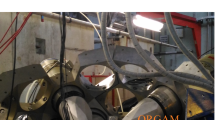Abstract
It is shown that the experimental energy characteristics of long-range \(\alpha\)-particles, considered as third particles emitted in spontaneous ternary fission of nuclei induced by neutrons, indicates that ternary nuclear fission, along with the previously studied processes of double \(\beta\)-decay and two-proton decay of nuclei, belongs to the class of two-step virtual nuclear decays, in which states of intermediate nuclei that lie outside the mass surface of the decay occur. The ternary fission widths and energy distributions of \(\alpha\)-particles were calculated based on the concepts of the quantum fission theory and the proposed virtual mechanism of ternary fission taking into account the fact that the \(\alpha\)-particle is emitted from the neck of the fissile nucleus in its configuration preceding the rupture of the nucleus into fission fragments. An estimate of the radius of the fissile nucleus neck for spontaneous ternary fission of \({}^{250,252}\)Cf, \({}^{248}\)Cm nuclei, as well as for ternary fission of \({}^{233,235}\)U nuclei induced by neutrons, has been obtained from the comparison of these energy distributions with experimental \(\alpha\)- particle distributions; it is consistent with the values of similar radii from calculations of the evolution of the fissile nucleus shape based on the generalized droplet model of the nucleus.

Similar content being viewed by others
REFERENCES
S. G. Kadmenskii, L. V. Titova, and D. E. Lyubashevskii, Phys. At. Nucl. 83, 311 (2020).
V. B. Berestetskii, E. M. Lifshitz, and L. P. Pitaevskii, Course of Theoretical Physics, Vol. 4: Quantum Electrodynamics (Pergamon, Oxford, 1982; Fizmatgiz, Moscow, 1959).
V. I. Gol’danskii, Sov. Phys. JETP 12, 348 (1960).
S. G. Kadmenskii and Yu. V. Ivankov, Phys. At. Nucl. 77, 1019 (2014).
S. G. Kadmenskii and Yu. V. Ivankov, Phys. At. Nucl. 77, 1532 (2014).
S. G. Kadmenskii and A. O. Bulychev, Bull. Russ. Acad. Sci.: Phys. 79, 872 (2015).
S. G. Kadmenskii and A. O. Bulychev, Bull. Russ. Acad. Sci.: Phys. 80, 921 (2016).
L. A. Sliv, Zh. Eksp. Teor. Fiz. 20, 1141 (1950).
V. I. Tretyak, Double Beta Decay: History and Current Status (Inst. Nucl. Res., 2014).
S. G. Kadmenskii, Yu. V. Ivankov, and D. E. Lyubashevskii, Phys. At. Nucl. 80, 903 (2017).
M. Mutterer and J. P. Theobald, Dinuclear Decay Modes (IOP Publ., Bristol, 1996), Chap. 1.
M. Mutterer, Yu. N. Kopatch, P. Jesinger, et al., Nucl. Phys. A 738, 122 (2004).
S. Vermote, C. Wagemans, O. Serot, et al., Nucl. Phys. A 837, 176 (2010).
S. G. Kadmenskii, L. V. Titova, and P. V. Kostryukov, Bull. Russ. Acad. Sci.: Phys. 82, 1299 (2015).
L. Nowicki, E. Piasecki, J. Sobolevsli, et al., Nucl. Phys. A 375, 187 (1982).
I. Halpern, Ann. Rev. Nucl. Sci. 21, 245 (1971).
P. Fong, Phys. Rev. C 3, 2025 (1971).
G. V. Val’skii, Sov. J. Nucl. Phys. 24, 140 (1976).
V. A. Rubchenya, Sov. J. Nucl. Phys. 35, 334 (1982).
J. P. Lestone, Phys. Rev. C 70, 021601(R) (2004).
A. Borh and B. Mottelson, Nuclear Structure (Benjamin, New York, 1977).
S. G. Kadmenskii, S. S. Kadmenskii, and D. E. Lyubashevskii, Phys. At. Nucl. 73, 1436 (2010).
S. G. Kadmenskii and L. V. Rodionova, Phys. At. Nucl. 72, 1798 (2009).
V. M. Strutinskii, Sov. J. Nucl. Phys. 6, 447 (1967).
M. Brack et al., Rev. Mod. Phys. 40, 320 (1972).
C. F. Tsang, Phys. Scr. A 10, 90 (1974).
O. Tanimura and T. Fliessbach, Z. Phys. 328, 475 (1987).
A. L. Barabanov, Symmetries and Spin-Angle Correlations in Reactions and Decays (Fizmatlit, Moscow, 2012) [in Russian].
M. Ya. Borkovskiy, Yu. M. Gusev, Y. K. Zalite, et al., Preprint no. 1540 (PINP, 1989).
S. Vermote, C. Wagemans, O. Serot, et al., Nucl. Phys. A 806, 1 (2008).
O. Serot, N. Carjan, and C. Wagemans, Eur. Phys. J. A 8, 187 (2000).
Author information
Authors and Affiliations
Corresponding author
Additional information
Translated by E. Baldina
About this article
Cite this article
Titova, L.V. A Virtual Mechanism of Ternary Nuclear Fission. Moscow Univ. Phys. 76, 320–325 (2021). https://doi.org/10.3103/S0027134921050179
Received:
Revised:
Accepted:
Published:
Issue Date:
DOI: https://doi.org/10.3103/S0027134921050179




